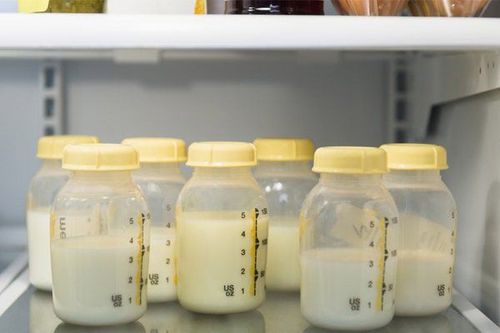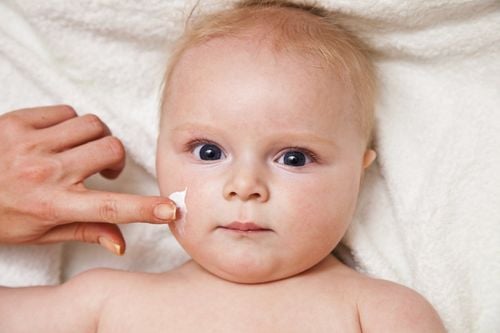This is an automatically translated article.
The article is professionally consulted by Master, Doctor Doan Ngoc Quynh Tram - Department of Pediatrics - Neonatology - Vinmec Nha Trang International General Hospital.
Storing breast milk sounds simple, but the reality is that it confuses many first-time mothers. The do's and don'ts are covered in the article regarding choosing a container, freezing breast milk, defrosting breast milk and some other tips.
1. Expressing breast milk
Before expressing breast milk, hands should be washed with soap and water or an antiseptic hand sanitizer containing at least 60% alcohol. Mothers can express breast milk manually or with a hand or electric pump.If a pump is used, the pump kit and tubing should be checked for cleanliness. It is recommended to clean the machine, buttons and switches with a disinfecting wipe first. Discard and replace moldy tubing immediately.
After use, the pump equipment should be stored carefully to avoid contamination.
2. Breast milk storage bottles/bags
Expressed milk should be stored in a clean, lidded bottle made of BPA-free glass or hard plastic (with recycling symbol 7). You can also use specialized plastic bags made to store and preserve breast milk.However, breast milk storage bags can tear, leak and become more susceptible to contamination than hard bottles. For safety, the bags should be placed in a sturdy plastic food storage container with a tight-fitting lid.
Do not store breast milk in disposable bottles or in common household plastic bags.

Nên dán nhãn ghi ngày sữa mẹ được vắt ra trên mỗi bình
3. How to freeze breast milk
Should do: Label each container with the date the breast milk was expressed; If you are in a child care facility, the child's name should be added to the label. Place the milk in the coolest place in the back of the refrigerator or in the freezer. In addition, mothers can also temporarily store milk in insulated items if a refrigerator or freezer is not available when traveling.Each storage bottle holds only the amount of milk your baby needs at one feeding, starting around 59 - 118ml and then adjusting as needed to avoid waste. You should also consider storing smaller portions (30-59ml) for unexpected situations, such as a later feeding time.
You can add freshly expressed breast milk to previously cooled or frozen milk on the same day. However, freshly expressed breast milk should be completely cooled in the refrigerator or freezer with an ice pack before adding.
Don't: Breast milk expands when frozen, so do not fill the container with milk. Do not freeze breast milk in the refrigerator door because the temperature from the door will change when opening and closing. Do not add freshly expressed and warm breast milk to frozen milk as this will cause the milk to partially thaw.
4. Breast milk storage time
The safe storage time of breast milk will depend on the storage method, volume of milk, outdoor temperature, temperature regulation in refrigerator/freezer, and cleanliness of the environment. Specific instructions for storing breast milk are as follows:Room temperature: Freshly expressed breast milk can be kept at room temperature for up to 6 hours. However, it is best to use or store within 4 hours, especially when the room is warm; Cooling insulation: Freshly expressed breast milk can be stored in insulated containers with ice packs for 1 day; Refrigerator: Freshly expressed breast milk can be stored in the back of the refrigerator for up to 5 days in clean conditions. However, it is best to use or store in the refrigerator within 3 days; Deep Freezer: Freshly expressed breast milk can be stored in the back of the freezer for up to 9 months. However, it is preferable to use up all frozen milk within 6 months. Studies show that the longer breast milk is refrigerated or frozen, the more vitamin C is lost in the milk. Moreover, breast milk stored from infancy will not fully meet the needs of the baby after a few months of age. In addition, breast milk freezing requirements may change for infants born prematurely, ill, or hospitalized, so parents should consult a doctor if a baby is unwell.
5. How to defrost breast milk?

Đặt bình/túi sữa đông lạnh vào tủ lạnh vào buổi tối khi có ý định sử dụng vào ngày hôm sau
In fact, breast milk doesn't need to be reheated, babies can be fed at room temperature or a little cooler. If you decide to warm the milk, you can either place the bottle under warm running water or put it in a bowl of warm water for a few minutes, no more than 20-30 minutes. It is recommended to keep the container tightly closed while reheating to ensure hygiene. Check the temperature of breast milk before feeding your baby by placing a few drops on the wrist, body temperature (37 degrees Celsius) is appropriate.
Don't: Do not heat frozen breast milk in the microwave or quickly heat it on the stove. This will cause the milk to have uneven hot and cold parts that will burn your baby. Some studies also show that rapid heating can affect milk's antibodies, destroying nutrients.
In addition, many experts recommend that you throw away thawed milk that has not been used up within 24 hours.
6. Smell and color after defrosting breast milk
The color of the milk can change depending on the mother's diet. In addition, thawed breast milk sometimes has a different smell from fresh milk, but is still safe for babies to use. If the baby refuses to suckle after thawing breast milk, you should shorten the storage time to limit the change in taste of the milk.In general, following the recommended do's and don'ts when storing breast milk will help nursing mothers maintain the safety and quality of expressed breast milk, thereby ensuring health for the baby.
As a key area of Vinmec Health system, Pediatrics Department always brings satisfaction to customers and is highly appreciated by industry experts with:
Gathering a team of top doctors and nurses in Pediatrics : consists of leading experts with high professional qualifications (professors, associate professors, doctorates, masters), experienced, worked at major hospitals such as Bach Mai, 108.. Doctors All doctors are well-trained, professional, conscientious, knowledgeable about young psychology. In addition to domestic pediatric specialists, the Department of Pediatrics also has the participation of foreign experts (Japan, Singapore, Australia, USA) who are always pioneers in applying the latest and most effective treatment regimens. . Comprehensive services: In the field of Pediatrics, Vinmec provides a series of continuous medical examination and treatment services from Newborn to Pediatric and Vaccine,... according to international standards to help parents take care of their baby's health from birth to childhood. from birth to adulthood Specialized techniques: Vinmec has successfully deployed many specialized techniques to make the treatment of difficult diseases in Pediatrics more effective: neurosurgery - skull surgery, stem cell transplantation. blood in cancer treatment. Professional care: In addition to understanding children's psychology, Vinmec also pays special attention to the children's play space, helping them to have fun and get used to the hospital's environment, cooperate in treatment, improve the efficiency of medical treatment. For more nutritional knowledge and child care for each age, parents should regularly visit the website vimec.com and make an appointment with the leading doctors, pediatric and nutrition experts of the International General Hospital. Vinmec when needing advice on children's health.
References: mayoclinic.org; cdc.gov














